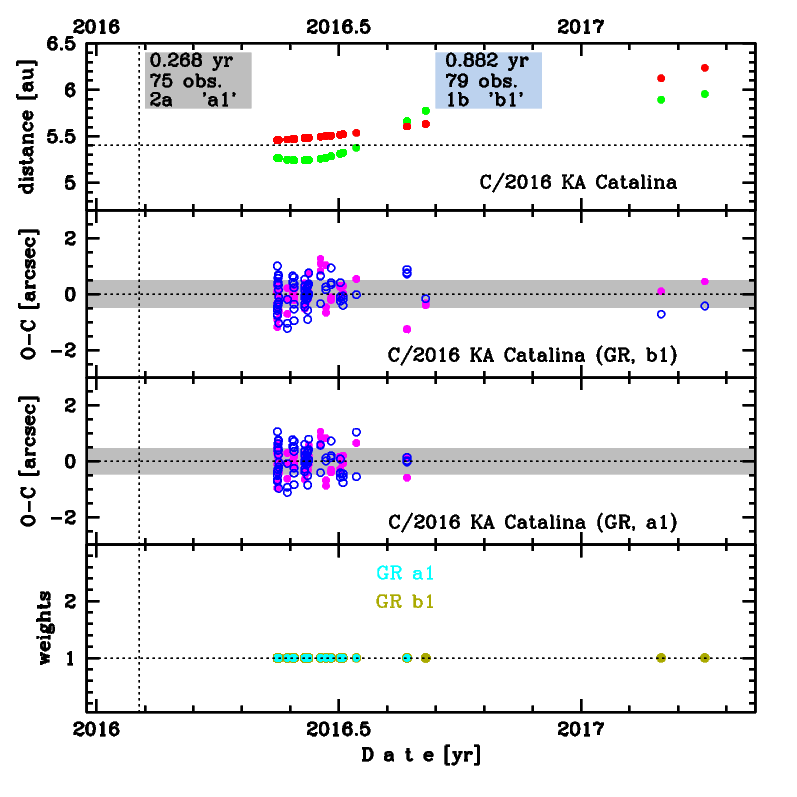C/2016 KA Catalina
more info
Comet C/2016 KA was discovered on 16 May 2016 with Catalina Sky Survey, that is about 3.5 months after its perihelion passage. This comet was observed about three months until 3 April 2017.
Comet had its closest approach to the Earth on 2 June 2016 (5.240 au), about 4 months after its perihelion passage and about 2 weeks after its discovery.
The preferred solution given here is based on data spanning over 0.88 yr in a range of heliocentric distances from 5.46 au to 6.24 au.
This comet suffers insignificant planetary perturbations during its passage through the planetary system; have orignal and future semimajor axes shorter than 5000 au.
Comet had its closest approach to the Earth on 2 June 2016 (5.240 au), about 4 months after its perihelion passage and about 2 weeks after its discovery.
The preferred solution given here is based on data spanning over 0.88 yr in a range of heliocentric distances from 5.46 au to 6.24 au.
This comet suffers insignificant planetary perturbations during its passage through the planetary system; have orignal and future semimajor axes shorter than 5000 au.
| solution description | ||
|---|---|---|
| number of observations | 79 | |
| data interval | 2016 05 16 – 2017 04 03 | |
| data type | observed only after perihelion (POST) | |
| data arc selection | entire data set (STD) | |
| range of heliocentric distances | 5.46 au – 6.24au | |
| detectability of NG effects in the comet's motion | NG effects not determinable | |
| type of model of motion | GR - gravitational orbit | |
| data weighting | NO | |
| number of residuals | 150 | |
| RMS [arcseconds] | 0.50 | |
| orbit quality class | 1b | |
| next orbit statistics, both Galactic and stellar perturbations were taken into account | ||
|---|---|---|
| no. of returning VCs in the swarm | 5001 | * |
| no. of escaping VCs in the swarm | 0 | |
| no. of hyperbolas among escaping VCs in the swarm | 0 | |
| next reciprocal semi-major axis [10-6 au-1] | 222.96 – 235.61 – 248.08 | |
| next perihelion distance [au] | 5.3849 – 5.3872 – 5.389 | |
| next aphelion distance [103 au] | 8.06 – 8.48 – 8.96 | |
| time interval to next perihelion [Myr] | 0.255 – 0.276 – 0.3 | |
| percentage of VCs with qnext < 10 | 100 | |

Upper panel: Time distribution of positional observations with corresponding heliocentric (red curve) and geocentric (green curve) distance at which they were taken. The horizontal dotted line shows the perihelion distance for a given comet whereas vertical dotted line — the moment of perihelion passage.
Middle panel(s): O-C diagram for a given solution (sometimes in comparison to another solution available in CODE), where residuals in right ascension are shown using magenta dots and in declination by blue open circles.
Lowest panel: Relative weights for a given data set(s).
Middle panel(s): O-C diagram for a given solution (sometimes in comparison to another solution available in CODE), where residuals in right ascension are shown using magenta dots and in declination by blue open circles.
Lowest panel: Relative weights for a given data set(s).
| next_g orbit statistics, here only the Galactic tide has been included | ||
|---|---|---|
| no. of returning VCs in the swarm | 5001 | * |
| no. of escaping VCs in the swarm | 0 | |
| no. of hyperbolas among escaping VCs in the swarm | 0 | |
| next reciprocal semi-major axis [10-6 au-1] | 222.97 – 235.61 – 248.09 | |
| next perihelion distance [au] | 5.3883 – 5.3904 – 5.3921 | |
| next aphelion distance [103 au] | 8.06 – 8.48 – 8.96 | |
| time interval to next perihelion [Myr] | 0.255 – 0.276 – 0.3 | |
| percentage of VCs with qnext < 10 | 100 | |